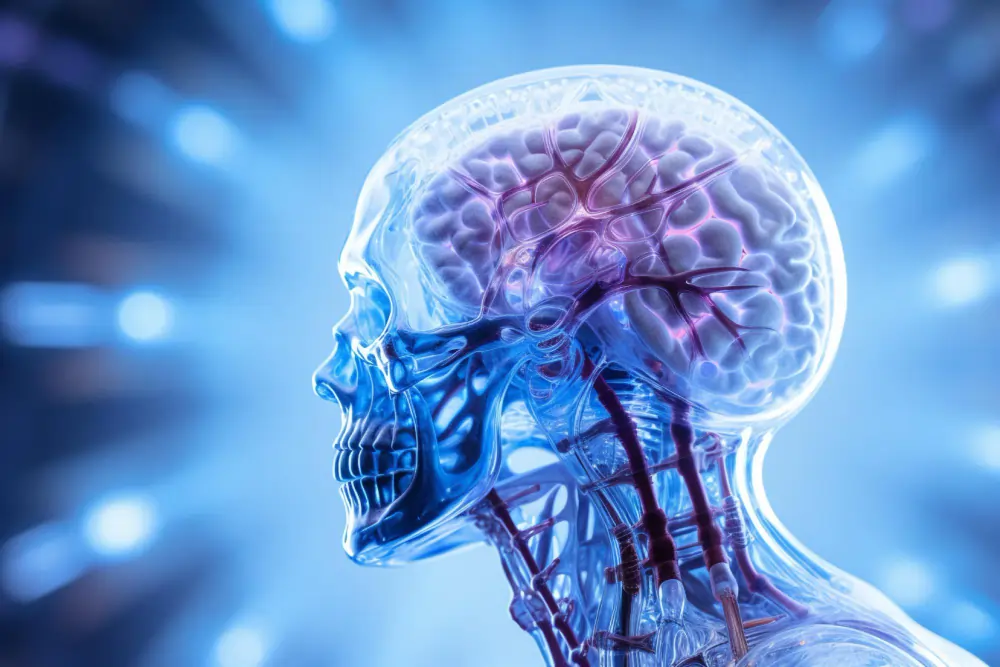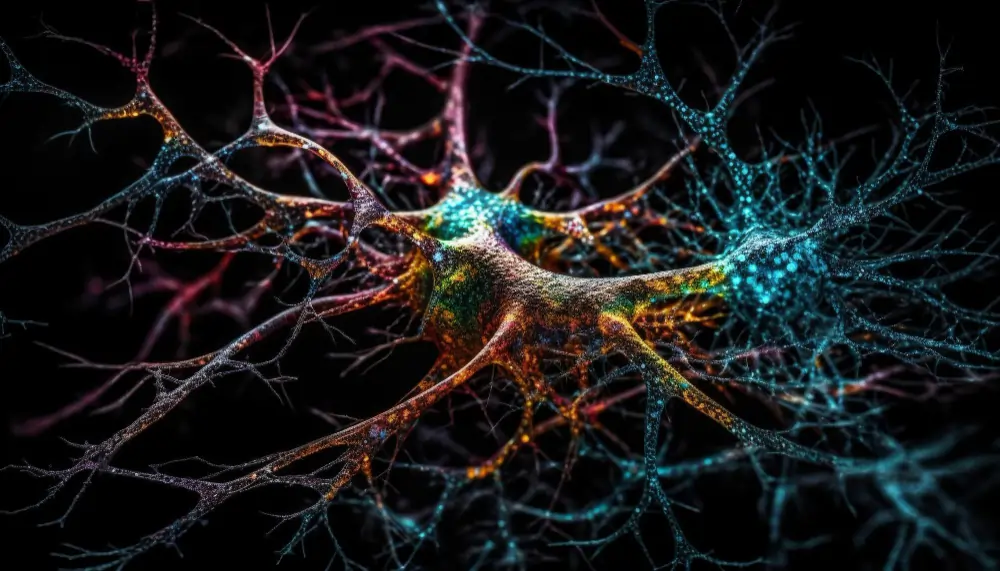
Introduction
Astrocytes, the star-shaped cells in the brain, play a vital role in maintaining brain health and function. They contribute to various processes that keep the brain sharp and functioning optimally. In this blog, we will delve into five key ways astrocytes contribute to brain health and sharpness, shedding light on their significance in the intricate workings of our most remarkable organ. Let’s explore the fascinating world of astrocytes and discover the remarkable impact they have on our cognitive well-being.
Astrocytes are a highly versatile type of glial cells found in the brain.
1. Supporting Neurons
Astrocytes play a crucial role in supporting the structure and function of neurons in the brain. They provide structural support by forming a network of interconnected processes that surround and embrace neurons. This physical support helps to maintain the integrity and stability of neurons, allowing them to effectively transmit signals and communicate with other cells in the brain.
Additionally, astrocytes contribute to the maintenance of the blood-brain barrier, a protective barrier that separates the brain from circulating blood. They form a tight seal between the blood vessels and the brain tissue, regulating the movement of substances between the blood and the brain. This barrier is essential for protecting the brain from potentially harmful substances, such as toxins and pathogens, while ensuring a stable and controlled environment for optimal brain function.
The support provided by astrocytes is of utmost importance for overall brain function. By structurally supporting neurons, astrocytes help to maintain neuronal connectivity and facilitate efficient communication between different regions of the brain. This support is essential for processes such as learning, memory, and cognition. Furthermore, the maintenance of the blood-brain barrier by astrocytes ensures that the brain receives the necessary nutrients and oxygen while being shielded from potentially damaging substances that could impede its function.
2. Regulating Blood Flow
Astrocytes, often referred to as the “glue” of the brain, are not only involved in neuronal support but also play a crucial role in regulating blood flow within the brain. This function, known as neurovascular coupling, is essential for maintaining optimal brain health and cognitive function.
Astrocytes interact closely with the blood vessels in the brain, specifically, the tiny capillaries that supply nutrients and oxygen to neurons. They have specialized processes called end-feet that wrap around the blood vessels, forming a close association. Through these end feet, astrocytes actively monitor the metabolic needs of neurons and respond by regulating blood flow accordingly.
When neurons become more active, such as during cognitive tasks or increased mental effort, they require more energy and oxygen. Astrocytes detect this increased metabolic demand and release signaling molecules, such as nitric oxide, prostaglandins, and calcium ions. These signaling molecules dilate the blood vessels, allowing for a greater supply of blood to the active areas of the brain. This process, known as vasodilation, ensures that neurons receive the necessary nutrients and oxygen to support their heightened activity.
Proper blood flow is crucial for cognitive functions due to its impact on neuronal activity and connectivity. When blood flow is regulated efficiently, it enhances the delivery of nutrients and oxygen to active brain regions, enabling optimal neuronal functioning. This, in turn, enhances various cognitive processes such as attention, memory, learning, and decision-making.
Recent research in this field has shed light on the intricate relationship between astrocytes and blood flow regulation. Studies have demonstrated that astrocytes can sense even subtle changes in neuronal activity and adjust blood flow accordingly. Furthermore, dysfunction in this astrocyte-mediated blood flow regulation has been implicated in various neurological disorders, including Alzheimer’s disease and stroke. This highlights the significance of understanding and maintaining proper blood flow regulation for overall brain health and cognitive well-being.
3. Balancing Neurotransmitters
Astrocytes, in addition to their structural and blood flow regulatory functions, also play a crucial role in balancing neurotransmitters in the brain. Neurotransmitters are chemical messengers that facilitate communication between neurons, and maintaining their balance is essential for optimal brain function.
Astrocytes actively participate in the regulation of neurotransmitter levels by removing excess neurotransmitters from the synaptic cleft, the tiny gap between neurons where communication occurs. They possess specialized transporters that uptake neurotransmitters, such as glutamate, from the synaptic cleft, preventing their accumulation and ensuring proper neurotransmission.
Glutamate is an excitatory neurotransmitter that promotes neuronal activity, while GABA (gamma-aminobutyric acid) is an inhibitory neurotransmitter that reduces neuronal activity. Astrocytes help maintain the balance between these two neurotransmitters by converting excess glutamate into glutamine through a process called glutamate-glutamine cycling. Glutamine is then transported back to neurons, where it can be converted back into glutamate or GABA as needed.
The balance of glutamate and GABA is crucial for mental clarity and sharpness. Too much glutamate can lead to overexcitation of neurons, resulting in excitotoxicity and neuronal damage. On the other hand, an imbalance towards low GABA levels can lead to hyperexcitability and impaired inhibitory control in the brain.
By effectively regulating the levels of glutamate and GABA, astrocytes ensure a balanced neurotransmitter environment, promoting optimal brain function. This balance is essential for maintaining mental clarity, focus, and sharpness. When neurotransmitters are in equilibrium, neuronal communication is efficient, allowing for proper information processing, memory formation, and cognitive functions.
4. Repairing Brain Injuries

Astrocytes, often referred to as the “support cells” of the brain, play a vital role in the repair and healing process after brain injuries. These injuries can include traumatic brain injuries, strokes, or neurodegenerative diseases. Astrocytes respond to such injuries by undergoing a process called reactive gliosis, which involves both protective and reparative mechanisms.
When the brain is injured, astrocytes become activated and undergo changes in their morphology and function. They proliferate and form a scar tissue known as a glial scar around the injured area. This scar acts as a physical barrier, preventing further damage and the spread of inflammation.
Furthermore, astrocytes release various molecules and growth factors that promote tissue repair and regeneration. They secrete factors like glial cell line-derived neurotrophic factor (GDNF), brain-derived neurotrophic factor (BDNF), and fibroblast growth factor (FGF), which support the survival and growth of neurons, along with promoting the formation of new blood vessels.
Astrocytes also play a crucial role in the regulation of the extracellular environment after injury. They help maintain ion balance, and pH levels, and regulate inflammation by releasing anti-inflammatory molecules. Additionally, they assist in clearing cellular debris and toxins, promoting a clean and conducive environment for the healing process.
Several studies have highlighted the significance of astrocytes in brain injury repair. For example, research has shown that astrocytes contribute to the formation of new neural connections, known as synaptogenesis, during the recovery phase after brain injuries. They also play a role in neuroplasticity, the brain’s ability to reorganize and adapt after injury, facilitating functional recovery.
In neurodegenerative diseases like Alzheimer’s and Parkinson’s, astrocytes are involved in the clearance of toxic protein aggregates, such as beta-amyloid plaques. They also provide metabolic support to neurons, helping to maintain their health and function.
Overall, astrocytes are crucial players in the repair and healing process after brain injuries. Their reactive gliosis response, scar formation, release of growth factors, regulation of the extracellular environment, and support in neuroplasticity contribute to the restoration of brain tissue and functional recovery. Ongoing research continues to explore the intricate mechanisms of astrocyte-mediated brain injury repair, offering potential avenues for therapeutic interventions in the future.
5. Supporting Synaptic Plasticity
Synaptic plasticity refers to the ability of synapses, the connections between neurons, to undergo changes in their strength and structure. It plays a crucial role in learning and memory formation, allowing the brain to adapt and store new information. Astrocytes, the star-shaped cells in the brain, contribute significantly to synaptic plasticity and have implications for cognitive health and sharpness.
Astrocytes actively participate in the modulation of synaptic transmission and the fine-tuning of neuronal connections. They extend their processes around synapses, forming a tripartite synapse consisting of the pre-synaptic neuron, post-synaptic neuron, and astrocyte. This tripartite arrangement allows astrocytes to interact with both neurons and synapses, influencing their activity.
Astrocytes contribute to synaptic plasticity through various mechanisms. They regulate the levels of neurotransmitters, such as glutamate and GABA, which are essential for synaptic communication. Astrocytes uptake excess glutamate, preventing its accumulation and potential excitotoxicity. By controlling the availability of neurotransmitters, astrocytes help maintain the balance necessary for synaptic plasticity.
Furthermore, astrocytes release signaling molecules, such as D-serine, which can modulate the activity of NMDA receptors, crucial for synaptic plasticity and learning. They also release factors like adenosine triphosphate (ATP), which can act as a signaling molecule to regulate synaptic strength and plasticity.
The implications of astrocyte-mediated synaptic plasticity for cognitive health and sharpness are significant. Synaptic plasticity is fundamental for learning and memory formation, allowing the brain to adapt to new information and experiences. By actively modulating synaptic transmission, astrocytes contribute to the efficient encoding and retrieval of memories, promoting cognitive function.
Maintaining optimal synaptic plasticity is crucial for cognitive health. Disruptions in synaptic plasticity have been associated with various neurological disorders, including Alzheimer’s disease, Parkinson’s disease, and cognitive decline. Astrocyte dysfunction can contribute to synaptic impairment and cognitive deficits observed in these conditions.
Understanding the role of astrocytes in synaptic plasticity may offer insights into potential therapeutic strategies for cognitive enhancement and the treatment of neurological disorders. By targeting astrocyte function, it may be possible to modulate synaptic plasticity and promote cognitive health and sharpness.
What is the function of astrocytes?
Conclusion
Astrocytes are essential for maintaining brain health and function. Their contributions to regulating the extracellular environment, supporting neuroplasticity, promoting neurogenesis, repairing brain injuries, and supporting synaptic plasticity are critical for keeping the brain sharp. As ongoing research continues to uncover the complexities of astrocyte function, we must prioritize brain health and stay informed about the latest developments in this field.
FAQs
1. What are astrocytes and what is their role in the brain?
Astrocytes are star-shaped cells in the brain that provide support and nourishment to neurons. They play a crucial role in maintaining brain health and function by regulating the extracellular environment, supporting neuroplasticity, promoting neurogenesis, repairing brain injuries, and supporting synaptic plasticity.
2. How do astrocytes regulate the extracellular environment?
Astrocytes help maintain the balance of ions, neurotransmitters, and other molecules in the brain’s extracellular space. They uptake excess neurotransmitters, regulate the levels of chemicals like potassium and glutamate, and provide metabolic support to neurons, ensuring a stable and optimal environment for neural signaling.
3. What is neuroplasticity, and how do astrocytes support it?
Neuroplasticity refers to the brain’s ability to change and adapt in response to experiences and learning. Astrocytes play a crucial role in supporting neuroplasticity by releasing signaling molecules, promoting the growth of new connections between neurons, and modulating synaptic strength and function.
4. Can astrocytes promote neurogenesis, the generation of new neurons?
Yes, astrocytes are involved in promoting neurogenesis, particularly in areas of the brain involved in learning and memory. They release factors that support the proliferation and differentiation of neural stem cells, leading to the formation of new neurons.
5. How do astrocytes contribute to brain repair after injury?
Astrocytes play a vital role in brain repair and recovery after injury. They form a scar tissue called a glial scar, which helps seal off the injured area, prevent further damage, and provide structural support for the healing process. Astrocytes also release factors that promote tissue repair and regeneration.


